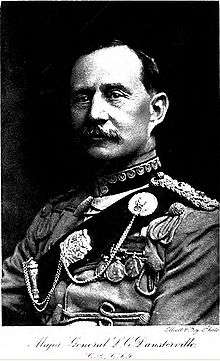Lionel Dunsterville
| Lionel Dunsterville | |
|---|---|
 Lionel Dunsterville | |
| Born |
9 November 1865 Lausanne, Switzerland |
| Died |
18 March 1946 (aged 80) Torquay, Devon, England. |
| Allegiance |
|
| Service/ |
|
| Rank | Major General |
| Battles/wars | World War I |
| Awards |
Companion of the Order of the Bath Companion of the Order of the Star of India |
Major General Lionel Charles Dunsterville CB CSI (9 November 1865 – 18 March 1946[1]) was a British general, who led the Dunsterforce across present-day Iraq and Iran towards Caucasus and oil-rich Baku.
Biography
Lionel Charles Dunsterville was born in Lausanne, Switzerland on 9 November 1865, the son of Lieutenant-General Lionel D'Arcy Dunsterville (1830-1912) of the Indian army and his wife, Susan Ellen (1835-1875). He went to school with Rudyard Kipling and George Charles Beresford at The United Services College, a public school later absorbed into Haileybury and Imperial Service College, which prepared British young men for careers in Her Majesty's Army. He served as the inspiration for the character "Stalky" in Kipling's collection of school stories Stalky & Co. He was also uncle to H.D. Harvey-Kelly, the first Royal Flying Corps pilot to land in France in World War I.
He was commissioned into the British Army infantry in 1884. Later he transferred to the colonial Indian Army and served on the North-West Frontier, in Waziristan and in China.
In the First World War he held a posting in India. At the end of 1917 the Army appointed Dunsterville to lead an Allied force of under 1,000 Australian, British, Canadian and New Zealand troops, drawn from the Mesopotamian and Western Fronts, accompanied by armoured cars, from Hamadan some 350 km across Qajar Persia. His mission was to gather information, train and command local forces, and prevent the spread of German propaganda.[2] On his way to Enzeli he also fought Mirza Kuchik Khan and his Jangali forces in Manjil.
Dunsterville was assigned to occupy the key oil-field and port of Baku, held by the Centro Caspian Dictatorship. However, the British and their allies had to abandon Baku on 14 September 1918 in the face of an onslaught by 14,000 Turkish troops, who took the city the next day. The Allies regained Baku within two months as a result of the Turkish armistice of 30 October 1918.
Promoted to major-general in 1918, Dunsterville died in 1946 at Torquay, Devon, England.
Family
Captain Lionel Charles Dunsterville of the Indian Staff Corps married Margaret Emily (known as "Daisie"), daughter of Captain John Walter Keyworth late 48th Regt., in November 1897 at Bishopsteignton, Devon, England.
Their elder son Lionel Walter Dunsterville was born on 9 September 1902 at Tientsin, China; their younger son Galfrid Charles Keyworth was born on 18 February 1905; and their daughter Susannah Margaret on 14 July 1911. Galfrid co-authored various books on Venezuelan orchids with L. A. Garay. Susannah's second husband was D. van Doorninck, whom she met in Switzerland during World War Two as a Resistance worker.
Sources
References
- Altstadt, A. L. (1992). The Azerbaijani Turks: Power and Identity under Russian Rule. Studies of nationalities. Stanford, CA: Hoover Institution Press, Stanford University. ISBN 0-81799-181-6.
- Bean, C. E. W. (1941) [1937]. "Appendix 5: Australians in Mesopotamia". The A. I. F. in France: December 1917 – May 1918. Official History of Australia in the War of 1914–1918. V (8th, online Australian War Memorial ed.). Sydney, NSW: Angus & Robinson. OCLC 12752507. Retrieved 15 November 2015.
- Dunsterville C. B., Major-General L. C. (1920). The Adventures of Dunsterforce. London: Edward Arnold. OCLC 317431. Retrieved 15 November 2015.
- Stalky's Reminiscences by Major-General L. C. Dunsterville (London: 1928; re-issued under title Stalky's Adventures in 1941)
- Something of myself by Rudyard Kipling
- Stalky and Co. by Rudyard Kipling
- S. P. Menefee, "Dunsterville, Lionel Charles," in H. C. G. Mathews and Brian Harrison (eds.), Oxford Dictionary of National Biography, vol. 17 (2004): pp. 361–63.
- Moberly, F. J. (1997) [1927]. The Campaign in Mesopotamia 1914–1918. History of the Great War Based on Official Documents, Compiled at the Request of the Government of India, under the Direction of the Historical Section of the Committee of Imperial Defence. IV. Part V: The Campaign in Upper Mesopotamia, 1917–18, North-West Persia and the Caspian, 1918 (Imperial War Museum and Battery Press repr. ed.). London: HMSO. ISBN 0-89839-290-X.
- Moberly, F. J. (1987) [1929]. Operations in Persia 1914–1919. History of the Great War based on Official Documents by Direction of the Committee of Imperial Defence (Imperial War Museum facsimile of the confidential 1929 ed.). London: HMSO. ISBN 0-11-290453-X.